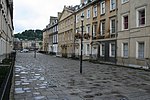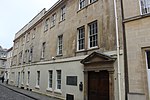Bath Spa railway station
DfT Category C1 stationsFormer Great Western Railway stationsGrade II* listed buildings in Bath, SomersetGrade II* listed railway stationsGreat Western Main Line ... and 6 more
Isambard Kingdom Brunel railway stationsPages with no open date in Infobox stationRailway stations in Bath, SomersetRailway stations in Great Britain opened in 1840Railway stations served by Great Western RailwayUse British English from September 2013

Bath Spa railway station is the principal station serving the city of Bath in South West England. It is on the Great Western Main Line, 106 miles 71 chains (106.89 mi; 172.0 km) down the line from the zero point at London Paddington between Chippenham to the east and Oldfield Park to the west. Its three-letter station code is BTH. The station is managed by Great Western Railway, who operate all trains at this station.
Excerpt from the Wikipedia article Bath Spa railway station (License: CC BY-SA 3.0, Authors, Images).Bath Spa railway station
Manvers Street, Bath Widcombe
Geographical coordinates (GPS) Address Nearby Places Show on map
Geographical coordinates (GPS)
| Latitude | Longitude |
|---|---|
| N 51.3775 ° | E -2.3564 ° |
Address
1
Manvers Street
BA1 1JP Bath, Widcombe
England, United Kingdom
Open on Google Maps










